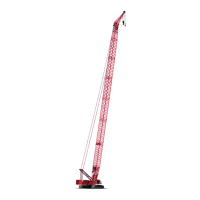Manitowoc Published 05-03-17, Control # 228-03 2-1
16000 SERVICE/MAINTENANCE MANUAL HYDRAULIC SYSTEM
SECTION 2
HYDRAULIC SYSTEM
This section contains maintenance, adjustment, and test
procedures for the hydraulic system and related components
on the Model 16000 crane. See the end of this section for
applicable hydraulic schematics.
Experienced technicians, trained in the operation of this
crane and its hydraulic system, shall perform the procedures
described in this section. The technicians shall read,
understand, and comply with the instructions in this section
and the display screen instructions in Section 3 of the 16000
Operator Manual.
For further information, contact the Manitowoc Crane
Care Lattice Team for an explanation of any procedure
not fully understood.
Adjustments described in this section were made to the
crane before it was shipped from the factory. Adjustments by
field personnel should only be necessary when parts are
replaced or when instructed by the Crane Care Lattice Team.
INSPECTING HYDRAULIC HOSES
Every Month or 200 Hours
Complete the following every month or 200 hours:
1. Visually inspect all hydraulic hose assemblies for the
following:
- Leaks in the hose or hose fittings
- Damaged, cut, or abraded cover
- Exposed reinforcement
- Kinked, crushed, flattened, or twisted hose
- Hard, stiff, heat-cracked, or charred hose
- Blistered, soft, degraded, or loose cover
- Cracked, damaged, or badly corroded fittings
- Fitting slippage on the hose
- Other signs of significant deterioration
If any of these conditions exist, evaluate the hose
assemblies for correction or replacement.
2. Visually inspect all other hydraulic components and
valves for the following:
- Leaking ports
- Leaking valve sections or manifolds, and valves
installed into cylinders or onto motors
- Damaged or missing hose clamps, guards, or
shields
- Excessive dirt and debris around hose assemblies
If any of these conditions exist, evaluate the component
for correction or replacement.
Degradation Due to Extreme Environment
Table 2-1 Climate Zone Classification
Salt Environment
Hydraulic hose assemblies operating in salt water climates
could see a significant reduction in service life. Regularly
inspect hydraulic hose assemblies per step 1.
Zone A and B
After 4,000 to 5,000 hours of service life, replace hydraulic
hose assemblies operating in climate zones A and B with
high ambient temperatures and high duty circuits. These
hoses could experience a 40% to 50% reduction in service
life.
Zone C
After 8,000 hours of service life, replace hydraulic hose
assemblies operating in climate zone C.
Zone D and E
Cold temperatures will reduce the service life of hose
assemblies operating in climate zones D and E.
CAUTION
Do not alter the hydraulic system specifications given in
this section without approval from Manitowoc Crane Care.
Altering specifications can cause damage to hydraulic
components and improper crane operation.
CAUTION
Burn Hazard!
Oil in the hydraulic tank may be under pressure and
extremely hot. Make sure that the hydraulic hose is
depressurized and cool to the touch before loosening any
connections.
Zone Description
A
Tropical Moist: All months average above 18° F (65° F).
Latitude: 15° - 25° N & S
B
Dry or Arid: Deficient precipitation most of the year.
Latitude: 20° - 35° N & S
C
Moist Mid-Latitude: Temperate with mild winters.
Latitude: 30° - 50° N & S
D
Moist Mid-Latitude: Cold winters.
Latitude 50° - 70° N & S
E
Polar: Extremely cold winters and summers.
Latitude: 60° - 75° N & S

